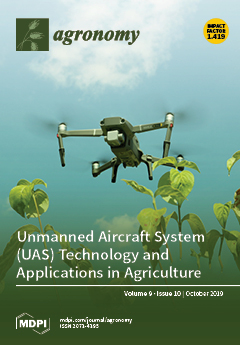Water deficit stress can negatively affect oil quality, crop yields and soil infertility. Thus, we investigated the effects of rice-straw biochar, foliar silicon and their combination on quality, yield and physiological traits of sunflower grown under three water deficit stress treatments. Water stress treatments were 50% (WS
0; no stress), 70% (WS
1; moderate stress) and 90% (WS
2; severe stress) depletion of the available soil moisture. The results showed that WS
1 and WS
2 negatively affected oil quality, mycorrhizal spores, yield and physiological traits of the sunflower; however, biochar, silicon and their combination significantly (
p ≤ 0.05) improved most of those traits. Oil and oleic acid contents of sunflower grown under WS
2 were decreased by 18% and 25.8% compared to those grown under WS
0, respectively. Nevertheless, the biochar and silicon combination resulted in higher oil (10.2%) and oleic acid (12.2%) in plants grown under WS
2 than those grown in untreated plots. Also, a significant increase (182% and 277%) in mycorrhizal spores was obtained in soil treated combination of biochar and silicon under WS
1 and WS
2 in comparison to untreated soil, respectively. On the other hand, plants grown under WS
1 and WS
2 exhibited reduced seed yield ha
−1 by 16.5% and 53.5% compared to those grown under WS
0, respectively. However, seed yield ha
−1 were increased by 26.8% and 27.1% in plots treated with combined treatment compared to untreated plants, respectively. In addition, the biochar and silicon combination significantly increased stomatal conductance by 21.4% and 12.1%, reduced proline by 56.6% and 51.2% and reduced catalase activity by 13.4% and 17.3% under WS
1 and WS
2 compared to those grown in untreated plots, respectively. Therefore, the combined treatment of biochar and silicon can minimize and alleviate the negative effects of WS
1 and WS
2, improve oil quality, physiological traits, microbial activity and seed yield ha
−1 in sunflower plants.
Full article





